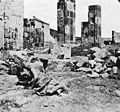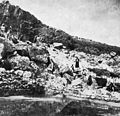|
Maria Jacobsen
Maria Jacobsen (November 6, 1882 – April 6, 1960) was a Danish missionary and a key witness to the Armenian genocide. Jacobsen wrote the Diaries of a Danish Missionary: Harpoot, 1907–1919, which according to Armenian genocide scholar Ara Sarafian, is "documentation of the utmost significance" for research of the Armenian genocide.[1] Jacobsen is known as "Mayrik" (Armenian: mother) or "Mama" for her humanitarian efforts and having saved many Armenians during the genocide.[1][2] Early lifeMaria Jacobsen was born in Denmark in the town of Siim near Ry on 6 November 1882 and as a child, she lived in Horsens with her father Jens Jacobsen and mother Ane Kristine Pedersen.[3][4][5] At an early age, Jacobsen had learned about the massacres of Armenians during the Hamidian massacres from the Danish media. Christian organizations throughout the world started a campaign to express their solidarity with the Armenians and to serve to help them. When Jessie Penn-Lewis, a feminist activist, came to Denmark from England in 1898, she helped form the Women's Missionary Workers (K.M.A.; Danish: Kvindelige Missions Arbejdere) in 1900.[3] Jacobsen soon participated in the support and relief efforts of orphans in the eastern provinces of the Ottoman Empire.[4] Armenian genocideWhen Maria Jacobsen arrived in Kharpert, she immediately started working in the American hospital located in the area.[6] In a diary entry regarding the deportation of Armenians, on 26 June 1915, Jacobsen stated that, "it is quite obvious that the purpose of their departure is the extermination of the Armenian people."[2][7] She added:
 Jacobsen also stated in her diaries that Turkish soldiers told her and other Danish missionaries, "Why do you give money and food to these people? They are only going out to the mountains to be killed."[6][7] On July 6, Maria Jacobsen and Danish missionary Tacy Atkinson reported that 800 of the males thirteen years and older who were arrested were "massacred" in a gorge.[7][8] Jacobsen then wrote about males over the age of nine who were taken to a mosque under the guardianship of "Kurds and gendarmes" who returned with their clothes covered with blood.[7][8]  Jacobsen described the situation of the Armenian orphans and the famine throughout the city:
Jacobsen later wrote about the circumstances of the deportees stating that 'these poor people did not look like humans any more, not even animals could be found in this state, people would be merciful and kill them'.[7] Serving as part of the Danish missionary, Jacobsen had taken thousands of children under her care and hid them from Turks.[3][4] She was known for taking care of an orphan that was a survivor of a group of orphans that were killed when thrown into a river. Jacobsen reported that the Turkish authorities demanded from the American missionaries to hand over the orphans, however, when this happened, many of them were killed.[8] Jacobsen also remarked about the Norwegian and Scandinavian media during the genocide:[6][7]
It was during this period that Jacobsen adopted three children. The first, Hansa, had fled the Bedouin family she was sold into and hid in a tree until she became unconscious from sickness and fell, where a Turk police officer and Jacobsen found her. Jacobsen chose to adopt her on the spot. The second child was Beatrice, and the third was Lilly, who she had found on the side of the road.[3] In April 1919 humanitarian supplies and personnel were finally allowed by authorities into the interior of Turkey. Lee Vrooman, 21, the driver of one of the supply trucks that delivered goods to Harpoot, was so impressed by Jacobsen, now 36, that he wrote to his mother about her.[9]
He went on at great length, finally concluding, “Believe me, she did a wonderful work, and she is just a youngster herself.”[10] What he may not have known was that during these four-and-a-half years, Jacobsen had also suffered for six months from typhus fever and cerebrospinal meningitis.[3][9] Later life
—Anne Stamboulian, an orphan under Jacobsen[2]
 After World War I, Maria Jacobson left the Ottoman Empire after contracting typhus from the orphans. After going to her native Denmark, she went to the United States where she gave a series of lectures and speeches on the plight of the Armenian people and the massacres that they have been subjected to. In the seven months that she spent in the United States, she managed to raise money for the orphans. After being prohibited from entering Turkey, Jacobsen subsequently went to Beirut, Lebanon where she continued to care for the orphans.[4] In January 1922, after the Armenian genocide, Jacobsen transferred many orphans to Beirut. After moving to Zouk Michail in July 1922, she helped establish an orphanage which sheltered 208 Armenian children from the region of Cilicia. Through the efforts of the Danish missionary, an Armenian orphanage that had previously been owned by the Near East Foundation was acquired by The Women's Missionary Workers (K.M.A.) in 1928. The orphanage, which was located in Byblos, became known as the "Bird's Nest".[4] Maria Jacobsen, who was also fluent in Armenian, often read the bible to the orphans in Armenian. Jacobsen also married an Armenian dentist.[2] Maria Jacobsen died on 6 April 1960 and is buried in the courtyard of Birds' Nest as desired by her will.[4] Recognition and legacy
GalleryMaria Jacobsen collected a series of photographs which she kept in her diary in 1919:[12]
See alsoReferences
|
||||||||||








